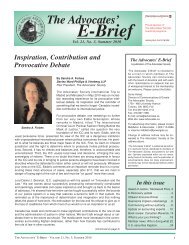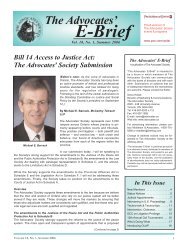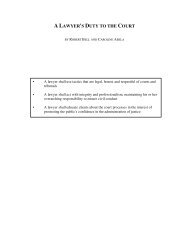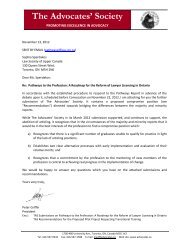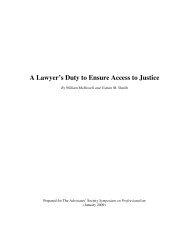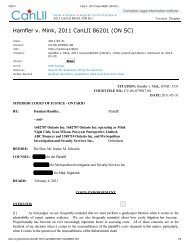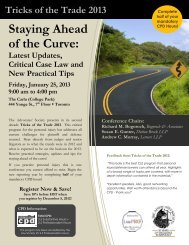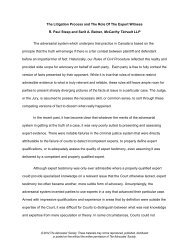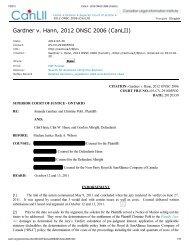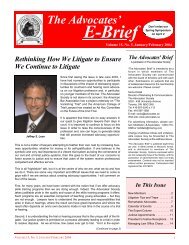History Cover & Text.qxp - The Advocates' Society
History Cover & Text.qxp - The Advocates' Society
History Cover & Text.qxp - The Advocates' Society
Create successful ePaper yourself
Turn your PDF publications into a flip-book with our unique Google optimized e-Paper software.
ness and affairs of the <strong>Society</strong>), BylawNo. 2 (dealing generally withmembership issues, and with theincrease in the number of Directorsfrom 10 to 15), and By-law No. 3(dealing with the borrowing of moneysand the issuance of securities bythe <strong>Society</strong>). <strong>The</strong> new 15-personBoard of Directors then was put intoplace.At this meeting, Isadore Levintermade remarked on the origins andjustifications of the <strong>Society</strong>. "<strong>The</strong>idea was conceived by a few of theyounger members of the profession,"he said, "who thought that anassociation should be formed for thepurpose of assisting those of the barwho are interested in counsel work.<strong>The</strong> association," he continued,"would provide a meetingplace to discuss commonproblems and would speak inone voice."Mr. Levinter's concept of the<strong>Society</strong> was not that it be asocial club, but that it existchiefly to encourage and helpyounger members of the barto become good counsel. Henoted that there was a shortageof good counsel not onlyin Canada, but also in theUnited States, and he quoted fromthe May issue of Trial, the voice ofthe American Trial Lawyers'Association: "<strong>The</strong> art of advocacy isin its sharpest decline in history, at atime when the demand by the publicand the bar for experienced triallawyers is at its peak."He went on to summarize the article'senumeration of the challengesfacing trial lawyers -- the need forthe guarantees of due process andthe availability of experienced counsel,the continuation of legal aid, thesurge of litigation resulting from thenation's ever-rising accident toll --and warned that the points made inthe article were equally relevant inCanada. "It is certainly part of theresponsibility of the senior membersof the bar to assist [in confrontingthese challenges] and <strong>The</strong><strong>Advocates'</strong> <strong>Society</strong>, it is hoped, willbe the vehicle to attain these accomplishments."He then concluded with a credo thatwould fuel the <strong>Society</strong> throughoutits now forty-year history. "I considerthis first meeting of the <strong>Society</strong> anhistoric occasion. In these times ofunrest, when the rights and libertiesof the people are slowly beinginfringed upon and taken away -and when those foundations uponwhich British liberty was built aregradually being undermined andchipped away and when morepower is being sought by an individualfew - we need more than evera strong, independent and courageousbar."“I consider this first meeting of the <strong>Society</strong>an historic occasion. In these times ofunrest, when the rights and liberties of thepeople are slowly being infringed upon andtaken away ... we need more than ever astrong, independent and courageous bar."Isadore Levinter, Q.C."This <strong>Society</strong> will provide a convenientplace in the downtown areawhere barristers, junior and senior,can meet at all times on commonground and where problems andtopics not only legal but of nationalconcern may be discussed. Out ofthis <strong>Society</strong> I trust will grow a powerfulgroup of barristers which willact as a body to give effect to theideals of liberty and justice forwhich it stands."To complete this momentous day, athird meeting was assembled at 5:15p.m., this being the First Meeting ofDirectors, the newly-formed 15-member group that included --besides Charter signees GordonFord, Q.C., Isadore Levinter, Q.C.,and J.J. Robinette, Q.C., -- Austin M.Cooper, Q.C., Charles L. Dubin,2Q.C., Richard E. Holland, Q.C.,James McCutcheon, Q.C., Charles F.McKeon, Q.C., Burton J. MacKinnon,Q.C., Robert S. Montgomery, Q.C.,and Robert F. Reid, Q.C.<strong>The</strong> most notable occurrence at thisthird meeting of the day was thenomination and acclamation of JohnJ. Robinette as the first President ofthe <strong>Society</strong>, and the subsequentselection of Mr. MacKinnon and Mr.Ford as Vice-presidents and Mr.McKeon as Secretary. Mr. Reidundertook the role of Treasurer, anda Membership Committee was putin place consisting of Mssrs.Montgomery (Chair), Holland,Levinter, and McCutcheon. Alsoestablished was a PremisesCommittee chaired by Mr.Sedgwick and including Mr.Levinter and Patrick Hartt,Q.C. Clearly, then, the seedshad been sown for the developmentof a vibrant andfunctionalorganization.professional<strong>The</strong> Directors met again amonth later, on June 25,1965. At that meeting, Mr.Hartt was appointed to representthe <strong>Society</strong> on a proposedcommittee in conjunctionwith the Canadian BarAssociation and the County of YorkLaw Association to prepare a suitablelist of persons for magistratesappointments. <strong>The</strong> young organizationwas already beginning to makeitself a player in legal circles, andthis marked the beginning of a longand honoured tradition of <strong>Society</strong>involvement in law reform andadministration.On May 6, 1966, the second annualMeeting of the Members of the<strong>Society</strong> was held, now inConvocation Hall at Osgoode Hall.<strong>The</strong> Treasurer noted that the <strong>Society</strong>has amassed a bank balance of$3,784.71, collected solely frommembership fees, and that a liabilityof $89.87 had been incurred due tothe cost of printing and mailing.



